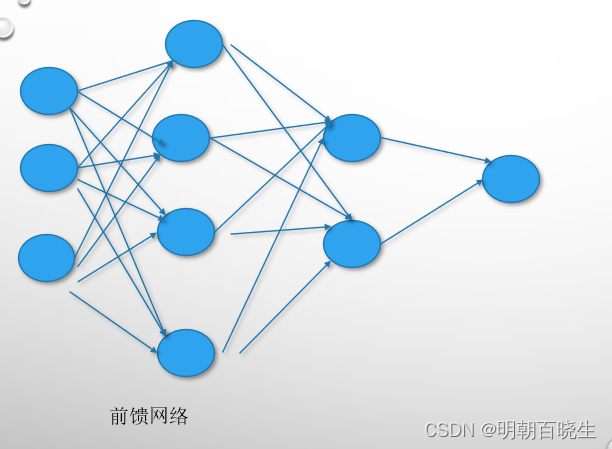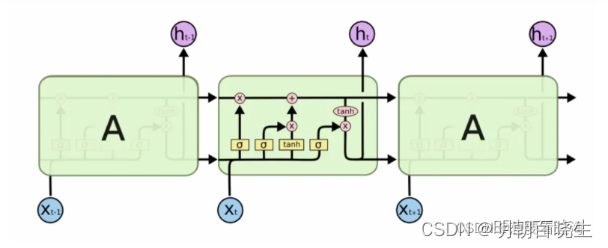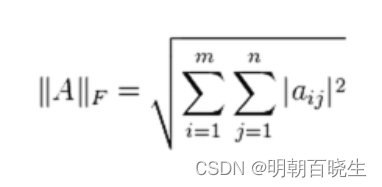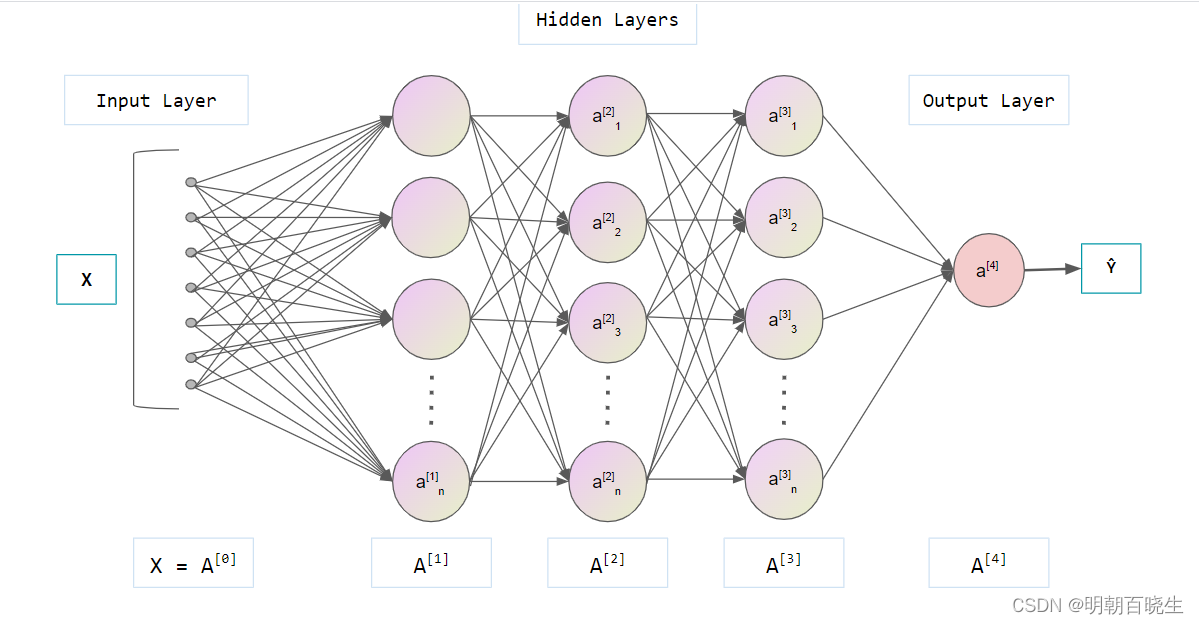-
神经网络与深度学习-9- 网络结构 -PyTorch
参考
《神经网络与深度学习》
目录
1: 常见网络结构
2: 前馈神经网络
3: 反向传播算法
4: Softmax 分类例子
## Versions:
- [Version 1.0](https://docs.google.com/presentation/d/11mR1nkIR9fbHegFkcFq8z9oDQ5sjv8E3JJp1LfLGKuk/edit?usp=sharing)
一 常见网络结构
1.1 前馈网络
定义:
每一层中的神经元接收前一层神经元的输出,并输出到下一层神经元。
主要包括:
全连接前馈网络 和 卷积神经网络

1.2 记忆网络
称为反馈网络,网络中的神经元不但可以接收其它神经元的信息,也可以接收自己的历史信息。 增加了记忆功能
主要包括:
RNN,LSTM,Hopfield,玻尔兹曼机,受限玻尔兹曼机

1.3 图网络
前面输入都可以表示向量或者向量序列,实际应用中很多数据是图结构数据,比如
知识谱,社交网络,分子网络。
主要包括:
图卷网络 Graph Conolutional Network
图注意网络: Graph Attention Network GAT
消息传递网络 Message Passing Neural Netwrok
二 前馈神经网络
2.1 前馈神经网络记号
 : 神经网络层数
: 神经网络层数 :第l层神经网络的个数
:第l层神经网络的个数 :第L层神经元的激活函数
:第L层神经元的激活函数 : l-1层到l层的权重系数矩阵
: l-1层到l层的权重系数矩阵 : l-1层到l层的偏置
: l-1层到l层的偏置 : l 层神经元的输入
: l 层神经元的输入 : l层神经元的输出
: l层神经元的输出

2.2 参数学习
这边以分类问题为例,其损失函数为

给定训练集
 ,将每个样本输入给前馈神经网络,得到网络的输出为
,将每个样本输入给前馈神经网络,得到网络的输出为 , 结构化风险函数为
, 结构化风险函数为
F: Frobenius 范数

在梯度下降法的每次迭代中,第l层的参数
 和
和 参数更新方式为
参数更新方式为Wl=Wl−α∂R∂Wl
Wl=Wl−α∂R∂Wl bl=bl−α∂R∂bl
bl=bl−α∂R∂bl 在神经网络的训练过程中经常使用反向传播算法来高效计算梯度
四 张量数据类型
pytorch 没有string 类型,对于单个字母用one-hot向量表示
如果是字符串,用word2vec 或者 glove 来实现
- # -*- coding: utf-8 -*-
- """
- Created on Mon Sep 5 21:50:02 2022
- @author: cxf
- """
- import torch
- def Debug():
- data = torch.randn(2,3)
- print("\n 数据类型: ",data.type(),"\t 维度 ",data.dim())
- data_gpu = data.cuda()
- hardware = isinstance(data_gpu, torch.cuda.FloatTensor)
- print("是否为GPU类型:",hardware)
- a = torch.tensor(1.0) #标量
- print("\n 标量: ",a.type(),a.shape,len(a.shape),a.size(),"\t 维度 ",a.dim()) #标量维度
- if __name__ == "__main__":
- Debug()
二 反向传播算法


以DNN为例:
输入:
训练集D={xn,yn}Nn=1
验证集V, 学习率α
repeat
训练集随机排序
for n =1 ... N do
选取样本(xn,yn)
前向传播:
zl=wlal−1+bl(神经元输入)
al=f(zl)(激活函数)
反向传播计算每一层的误差δl
∂J∂WL=∂J∂zL(aL−1)T
∂J∂bL=(∂zL∂bL)T∂J∂zL=E∂J∂zL=∂J∂zL
∂J∂zL=Diag(σ′(zL))(aL−y)
=(aL−y)⊙σ′(zL)
求l层:

更新每一层的导数
∂J∂Wl=δl(al−1)T
∂J∂bl=δl
更新每一层的参数
wl=wl−α(δl(al−1)T+λwl)
bl=bl−αδl
损失函数
J=||aL−y||2
- import torch
- import torch.utils.data as Data
- import numpy as np
- '''
- shuffle:(数据类型 bool)
- 洗牌。默认设置为False。在每次迭代训练时是否将数据洗牌,默认设置是False。
- 将输入数据的顺序打乱,是为了使数据更有独立性
- num_workers:(数据类型 Int)
- 工作者数量,默认是0。使用多少个子进程来导入数据。
- 设置为0,就是使用主进程来导入数据。注意:这个数字必须是大于等于0的,负数估计会出错。
- drop_last:(数据类型 bool)
- 丢弃最后数据,默认为False。设置了 batch_size 的数目后,
- 最后一批数据未必是设置的数目,有可能会小些。这时你是否需要丢弃这批数据。
- '''
- def load(x,y,batch):
- BATCH_SIZE = batch #批训练数据量的大小
- trainset = Data.TensorDataset(x, y) #训练数据集
- #创建一个dataloader类的实例
- loader = Data.DataLoader(
- dataset=trainset,
- batch_size=BATCH_SIZE,
- shuffle=True,
- num_workers=2,
- drop_last = True)
- return loader
- '''
- 显示数据集
- '''
- def sampling(x,y,batch):
- loader = load(x,y,batch)
- for epoch in range(1):
- print("\n--------------------")
- for batch_idx, (batch_x, batch_y) in enumerate(loader):
- #print("\n batch_idx:{},\n batch_x:{}, \n batch_y:{}".format(batch_idx, batch_x, batch_y))
- return batch_x, batch_y
- '''
- 随机采样的API
- '''
- def sampling(x,y,batch,N):
- indices = np.arange(0,N)
- np.random.shuffle(indices)
- indices1 = indices[0:batch]
- index = torch.tensor(indices1,dtype=torch.int)
- #indices = torch.tensor([0, 2])
- trainData = torch.index_select(x, 0, index) #行抽取
- trainLabel = torch.index_select(y, 0, index) #行抽取
- print("\n trainlabel ",trainLabel)
- return trainData, trainLabel
- ----------------
- # -*- coding: utf-8 -*-
- """
- Created on Tue Nov 8 17:09:56 2022
- @author: chengxf2
- https://blog.51cto.com/u_15132389/4755744
- """
- import numpy as np
- import torch
- from sklearn.datasets import load_iris
- import sampling
- import torch.nn.functional as F
- class BP:
- '''
- 损失值
- args
- y: 标签值
- predY: 预测值 [150, 4]
- return
- loss 值
- '''
- def loss(self, y, predY):
- s = -torch.mm(y.T, torch.log(predY))
- loss = s.numpy()[0,0]
- #print("\n s ",loss)
- return s
- '''
- 激活函数
- args
- x: 输入
- return
- y: 输出
- '''
- def softmax(self,x):
- y = F.softmax(x,dim=0) #1 行
- """
- z = torch.exp(x)
- s = z.sum()
- y = z/s
- """
- return y
- '''
- 训练
- args
- trainData: 训练数据集
- trai
- '''
- def train(self):
- m=150
- W =0
- trainData = self.x
- trainLabel = self.y
- W = torch.ones((3,4))
- m,n = self.x.shape[0],self.x.shape[1]
- print("\n m ",m, "\t n ",n)
- trainData, trainLabel = sampling.sampling(self.x,self.y, self.batch,m)
- for j in range(self.maxIter):
- for i in range(self.batch):
- x = trainData[i].view(4,1)
- y = trainLabel[i].view(3,1)
- a = torch.mm(W, x)
- predY = self.softmax(a)
- deltaW = torch.mm(predY-y,x.T)
- W= W-self.learnRate*deltaW
- loss = self.loss(y, predY)
- print("\n i %d loss %7.3f"%(j,loss))
- print(W)
- '''
- 加载数据集#[100,4]
- '''
- def load_data(self):
- iris = load_iris()
- x = iris.data #数据
- y = iris.target #特征
- print("\n数据集数据的形状:", x.shape) #[150,4]
- print("\n数据集的标签:\n", y) #[0,1,2]
- self.x = torch.tensor(x, dtype=torch.float)
- self.m, self.n = self.x.shape[0], self.x.shape[1]
- self.y =torch.zeros([self.m,3],dtype=torch.float)#one-hot
- for i in range(self.m):
- j = y[i]
- self.y[i,j] =1.0
- def __init__(self):
- self.m = 0
- self.n = 0
- self.batch = 20 #从每类数据中随机选取40个
- self.maxIter = 1000 #最大迭代次数
- self.learnRate = 0.1 #学习率
- if __name__ == "__main__":
- bp = BP()
- bp.load_data()
- bp.train()
-
相关阅读:
Java SE 16 新增特性
群狼调研(长沙产品概念测试)|如何做新品上市满意度调研
【基于FreeRTOS的STM32F103系统】简介及官方文件移植
计算机毕业设计(附源码)python中学线上作业评判系统
使用maven 3.8.3 创建并运行java web项目
presto搭建,并配置hive
超出社保公积金免税上限,纳税方案
reactnative 底部tab页面@react-navigation/bottom-tabs
clickhouse运维常用语句
【AI】第 1 章:你的深度学习之旅
- 原文地址:https://blog.csdn.net/chengxf2/article/details/126628577
